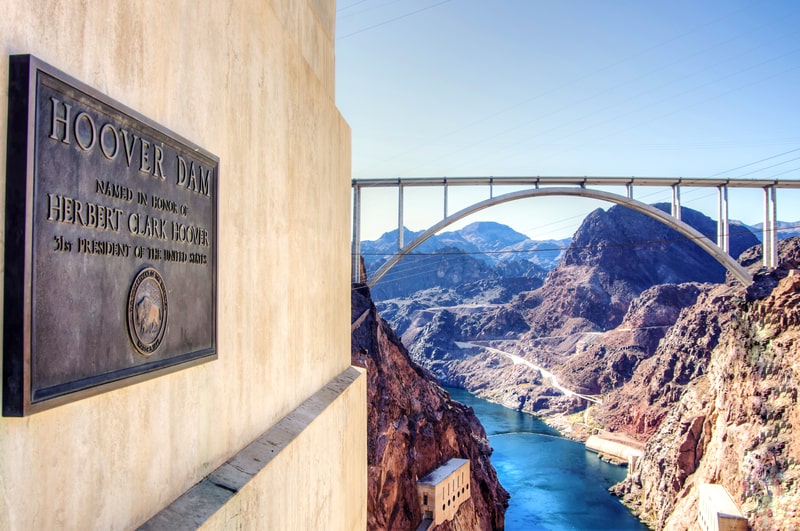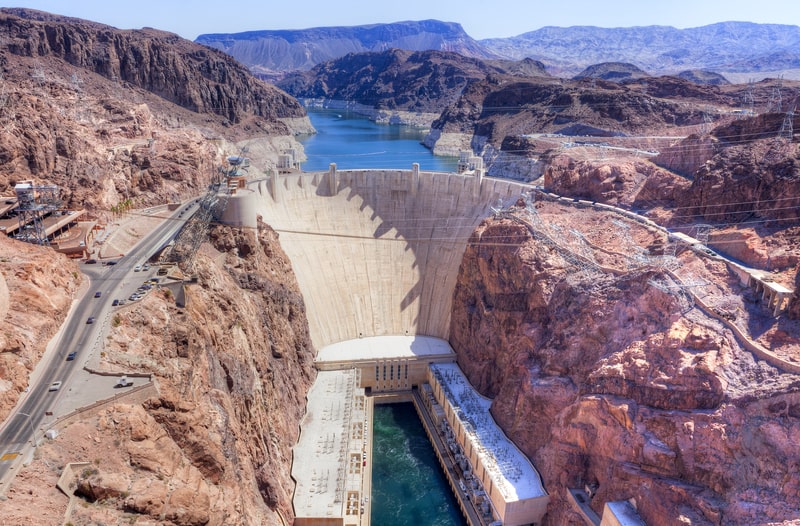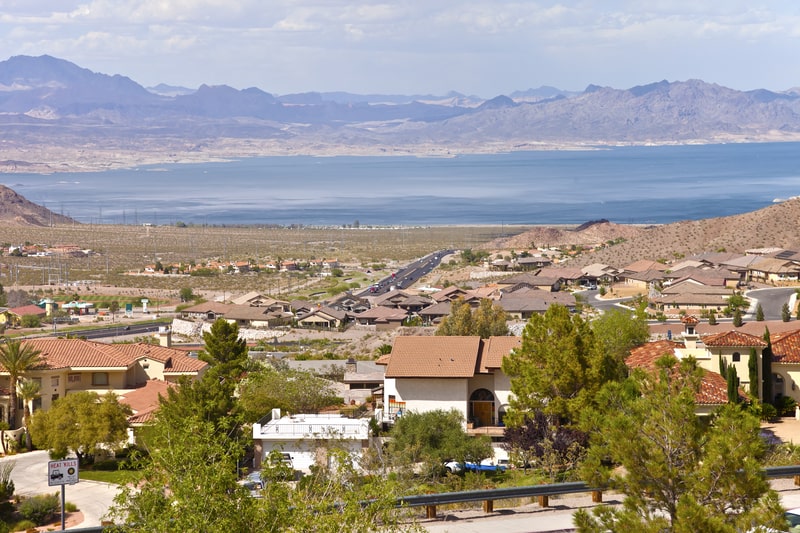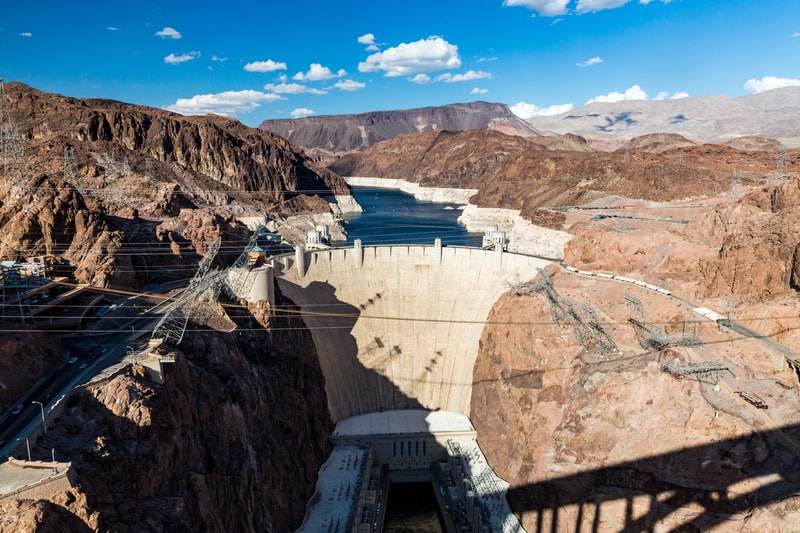Last updated on November 15th, 2022
The Hoover Dam is a historic landmark that continues to impress almost a century after its completion. It is a triumph of engineering and architecture. It got done despite countless challenges, from political wrangling to technical hurdles. Unlike most megaprojects, it even finished ahead of time. Whether you are a student conducting research or an individual satisfying your curiosity, you will learn a lot through these 50 interesting facts about Hoover Dam.
The Origins of the Hoover Dam
1. What’s in a Name?

President Herbert Hoover, an engineer, was synonymous with the project. However, the Great Depression sullied his reputation, and the name changed to “Boulder Dam.” In 1947, a more forgiving Congress restored the term “Hoover Dam.”
2. Catastrophic Floods
In the 1890s, the Alamo Canal provided irrigation from the Colorado River. The valley became suitable for settlement and farming until catastrophic floods ruined communities. Controlling the water became essential, paving the way for Hoover Dam.
3. Hydro-electric Power Potential
Thomas Edison, the famous inventor, saw the potential of the Hoover Dam site for hydroelectric power generation. Yet early 1900s technology limited power transmission to 80 miles. Few customers were within the vicinity, so he dropped the project.

4. A Federal Concern
In 1922, the reclamation Service pushed for the construction of the Hoover Dam. Yet big projects cost big money. Who should shoulder the bill? They pointed to the federal government because the basin covers several states.
5. Site Evaluations
Boulder Canyon seemed ideal until scientists discovered a geologic fault. Other locations? No space for a spillway or construction camp. Eventually, the dam moved to Black Canyon, but people kept calling it the “Boulder Canyon Project.”
6. Proactive Litigation Avoidance
Nobody wants endless court cases. Herbert Hoover, then the Secretary of Commerce, met with representatives of the seven affected states to discuss the project details. They signed the Colorado River Compact on November 24, 1922.
7. The 1927 Mississippi Flood
Expensive and frivolous. That’s how other states viewed the Hoover Dam, delaying its approval. In 1927, the destructive Mississippi Flood softened the hearts of Southern and Midwestern lawmakers, allowing construction to begin.
8. The St. Francis Dam Failure
What happens if the dam fails? This question was on everyone’s mind in 1928 when St. Francis Dam in LA gave way and killed 600 people. Engineers reviewed the Hoover Dam plans and made ultra-conservative modifications.
9. The Boulder Canyon Project Act
At the end of 1928, President Coolidge signed off on the Boulder Canyon Project with a budget of $165 million. It included the Hoover Dam, the Imperial Dam, and the All-American Canal to replace the Alamo Canal.
10. A Savage Design Engineer
John Savage led the design as the chief engineer at the Bureau of Reclamation. He supervised the construction of 60 dams throughout his career and surveyed the Three Gorges Dam in China.
Design and Preparations
11. An Arch-Gravity Dam
Savage and his team designed a concrete arch-gravity dam. It leans into the water to prevent buckling under pressure and transfers the load to the rock walls for support. The bottom is also thicker than the top, like a curved ax.
12. Dam Dimensions
It was an engineering marvel. The wedge-shaped dam rose 220 meters, with a thickness of 200 meters at the base and 14 meters at the top. It even had space on the crest for a two-lane Nevada-Arizona highway.
13. The Time Limit
Complete it in seven years or face penalties – that was the marching order for the contractor. Construction began in 1931. Despite numerous challenges, it opened in 1936, way ahead of schedule.
14. The Winning Bid
Interested parties formed joint ventures to pool resources. The self-descriptive Six Companies, Inc. won with the lowest bid of $48 million for site preparation and dam construction. The government provided the materials.
15. A New City

A long-term project requires a strategic base. Seven miles away from the dam site, they built a settlement for government employees and contractors. An asphalt highway made work commutes easier. It still exists today as Boulder City.
16. Rail Transport
Tons of materials had to come in by rail. Before starting with the Hoover Dam, they installed 22.7 miles of railroad from Las Vegas to Boulder City and another 10 miles to the dam site.
17. Power Lines
The isolated construction site needed power. Lots of it! Contractors built a 222-mile transmission line from San Bernardino in California to Black Canyon to light it up.
18. A Labor Magnet
Thousands of job-seekers converged around Boulder City, building makeshift camps. Employment peaked at 5,251 in July 1934. Men came and went, with the total reaching over 21,000.
19. An Early Start for Construction
In 1931, an impatient President Hoover pulled the start date from October to March. Boulder City was incomplete, so the company scrambled to build bunkhouses beside the canyon walls.
20. Safety Equipment
What they lacked in equipment, the workers made up for with ingenuity. Some dipped cloth hats in tar and let them harden. It saved them from head injuries. Six Companies eventually ordered thousands of hard hats for the men.

The Construction Process
21. Site Preparation
How do you build on a river? First, you make the site dry. Workers dug four large tunnels to divert the water. They finished earlier than scheduled and timed diversion with the lowest annual water level for safety.
22. Tunnel Specifications
The tunnels are 15 meters in diameter, with one-meter thick concrete walls for strength, and a combined length of nearly 5 kilometers. Two are on the Arizona side, and another two are on the Nevada section.
23. Cofferdams for Flood Prevention
You can never be too careful! Designers were keen to prevent a flooded worksite. The strategy? Building two cofferdams: 29 meters high and 230 meters thick at the base – that is even thicker than the Hoover Dam itself.
24. Cleaning the Riverbed
Removing water is not enough. Workers had to excavate loose materials until they reached the solid rock for the foundation. They moved a staggering one million cubic meters of soil and sand to get there.
25. Side-wall Excavation
Brave workers had a death-defying task: clean up the walls by removing weathered rocks. They used dynamites and jackhammers while suspended on ropes, exposing the strong virgin rock required to support the dam.
26. Unlikely Tourist Attractions

These high-scalers attracted media attention. They showed off as crowds cheered them on. One earned the nickname “Human Pendulum” for swinging co-workers across the canyon and using cases of dynamite for an explosive finale.
27. Stacking Blocks
Concrete heats up while it cures. A single continuous pour of the Hoover Dam would require 125 years of cooling. That is way beyond the 7-year deadline! Engineers sped it up by pouring it into many discrete forms, effectively stacking Lego blocks and adding reinforcement.
28. Cooling Pipes
Engineers had another trick up their sleeves. They placed steel pipes with flowing ice water into the concrete forms. The cold water absorbed the heat and moved it elsewhere. Workers filled the holes with grout afterward.
29. A Concrete Journey
The concrete mix originates from two Nevada plants. It goes into buckets 7 feet high before site delivery via rail cars. Aerial cables send the buckets from the top of the canyon down to the dam.
30. Total Concrete Volume
The Hoover Dam used around 2.5 million cubic meters of concrete poured over two years. That is enough material to pave a two-lane highway from California to New York.
Beyond the Dam
31. Hoover Who?
Work was winding down by September 30, 1935. President Franklin Roosevelt led a dedication ceremony with 10,000 in attendance. Despite his ties to the dam, former President Hoover did not get an invitation.
32. Commemorative Stamp

The US Post Office marked the occasion with a three-cent stamp. It bore a bird’s eye view of the structure and the surrounding canyon, under which was “BOULDER DAM.” It was the official project name from 1933 to 1947.
33. Federal Turnover
Six Companies arranged the formal transfer to the US government. They signed the agreement on March 1, 1936, but work on the powerhouse and other sections went on.
34. Plain to Fabulous
A grand project must have a grand facade. After receiving criticisms, the architect Gordon Kaufman redesigned the exteriors into an elegant Art Deco style. He also hired artists to improve the visuals.
35. Native American Motifs
The muralist Allen Tupper True designed the walls and floors of Hoover Dam. True used Navajo and Pueblo tribal motifs from ceramics, baskets, textiles, and sand paintings. The versatile artist even implemented a color-coding scheme for the pipes and machinery.
. . . continue reading on the next page
